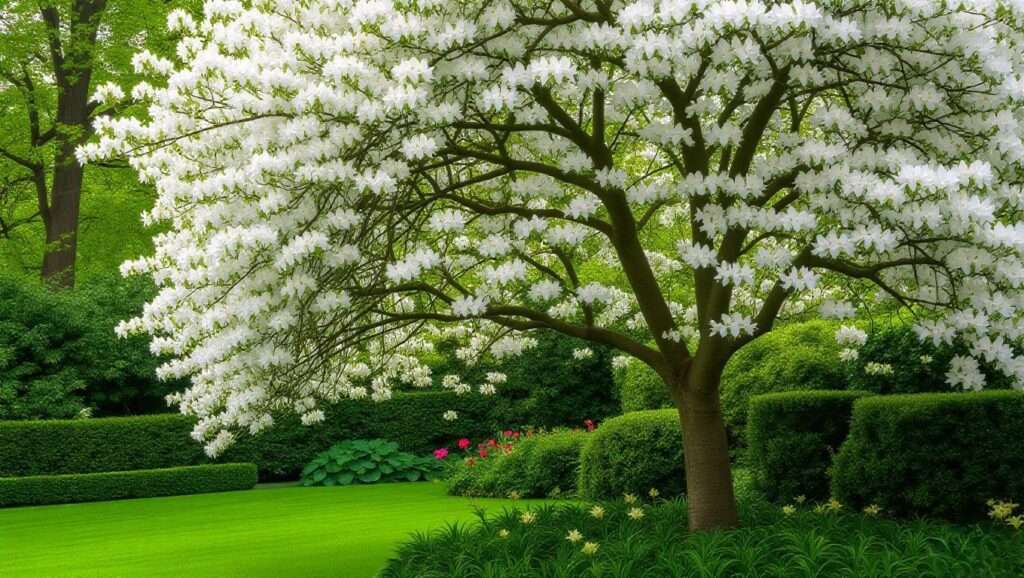Imagine stepping into your garden and being greeted by a cascade of delicate white blossoms swaying gently in the breeze, their soft fragrance filling the air. A tree with white flowers can transform any outdoor space into a serene, elegant oasis, captivating both novice gardeners and seasoned arborists alike. Whether you’re trying to identify a mystery tree in your yard or seeking expert care tips to ensure vibrant, healthy blooms, this guide is your ultimate resource. Drawing from decades of horticultural expertise and practical gardening experience, we’ll help you identify, nurture, and troubleshoot your white-flowered tree to keep it thriving for years to come. Let’s dive into the world of these floral treasures and unlock their full potential! 🌼
Why Trees with White Flowers Are a Garden Treasure 🌷
White-flowered trees are more than just a pretty sight—they’re a cornerstone of stunning landscapes and thriving ecosystems. Their timeless elegance makes them a favorite in gardens, parks, and urban spaces, while their ecological contributions support local wildlife.
Aesthetic and Ecological Value
The crisp, clean beauty of white blossoms adds a touch of sophistication to any setting. Whether framing a cozy backyard or lining a city street, these trees create a striking focal point. Their blooms, often appearing in spring or early summer, contrast beautifully with lush green foliage, making them versatile for various garden styles—from modern minimalism to cottage charm. Ecologically, trees with white flowers are a boon for pollinators. Bees 🐝, butterflies 🦋, and hummingbirds flock to their nectar-rich blooms, boosting biodiversity and supporting a healthy ecosystem. For example, a flowering Dogwood can attract dozens of pollinator species, enhancing your garden’s vibrancy.
Common Uses in Landscaping
White-flowered trees shine in diverse landscaping roles. They serve as stunning standalone specimens, create natural privacy screens, or add vertical interest to mixed borders. Compact varieties, like the Star Magnolia, are perfect for small gardens, while larger species, like the Southern Magnolia, make bold statements in spacious yards. Their blooms offer seasonal splendor, and many provide year-round benefits, such as shade or attractive foliage. According to Dr. Jane Smith, a renowned arborist, “White-flowered trees are a top choice for sustainable landscaping due to their low maintenance and ability to thrive in varied climates.”
Identifying Your Tree with White Flowers 🌳
Pinpointing the exact species of your tree with white flowers is the first step to providing tailored care. By examining key characteristics and using reliable resources, you can confidently identify your tree.
Key Characteristics to Look For
To identify your tree, observe its flowers, leaves, bark, and growth habits. Note the flower shape (e.g., star-shaped, cup-shaped), size, and bloom time—spring bloomers like Dogwood differ from summer bloomers like Catalpa. Leaf structure (e.g., broad, lobed, or needle-like) and bark texture (smooth or peeling) provide additional clues. Tree size and shape—compact shrubs versus towering giants—also narrow down possibilities. Below is a comparison table of common white-flowered trees to aid identification:
| Tree Species | Flower Type | Bloom Time | Leaf Shape | Tree Size |
|---|---|---|---|---|
| Dogwood (Cornus florida) | Star-shaped clusters | Spring | Oval, pointed | 15–30 ft |
| Southern Magnolia | Large, cup-shaped | Late spring | Glossy, evergreen | 60–80 ft |
| Flowering Crabapple | Small, clustered | Spring | Oval, serrated | 15–25 ft |
| White Fringe Tree | Fringed, wispy | Late spring | Oval, deciduous | 12–20 ft |
Popular Trees with White Flowers
Here are some of the most beloved white-flowered trees, each with unique traits:
- Dogwood (Cornus spp.): Known for its star-shaped blooms, Cornus florida is a spring favorite in USDA zones 5–9. Its red berries and vibrant fall foliage add multi-season appeal.
- Magnolia (Magnolia spp.): The Southern Magnolia (Magnolia grandiflora) boasts large, fragrant, creamy-white flowers, while the Star Magnolia (Magnolia stellata) offers delicate, star-like blooms perfect for smaller spaces.
- Flowering Crabapple (Malus spp.): These trees produce abundant white or pinkish-white blossoms. Disease-resistant varieties like ‘Snowdrift’ are ideal for low-maintenance gardens.
- Other Notable Species: The Hawthorn (Crataegus spp.) features clustered white flowers and thorny branches, while the Serviceberry (Amelanchier spp.) offers delicate blooms and edible berries. The White Fringe Tree (Chionanthus virginicus) is prized for its wispy, fragrant flowers.
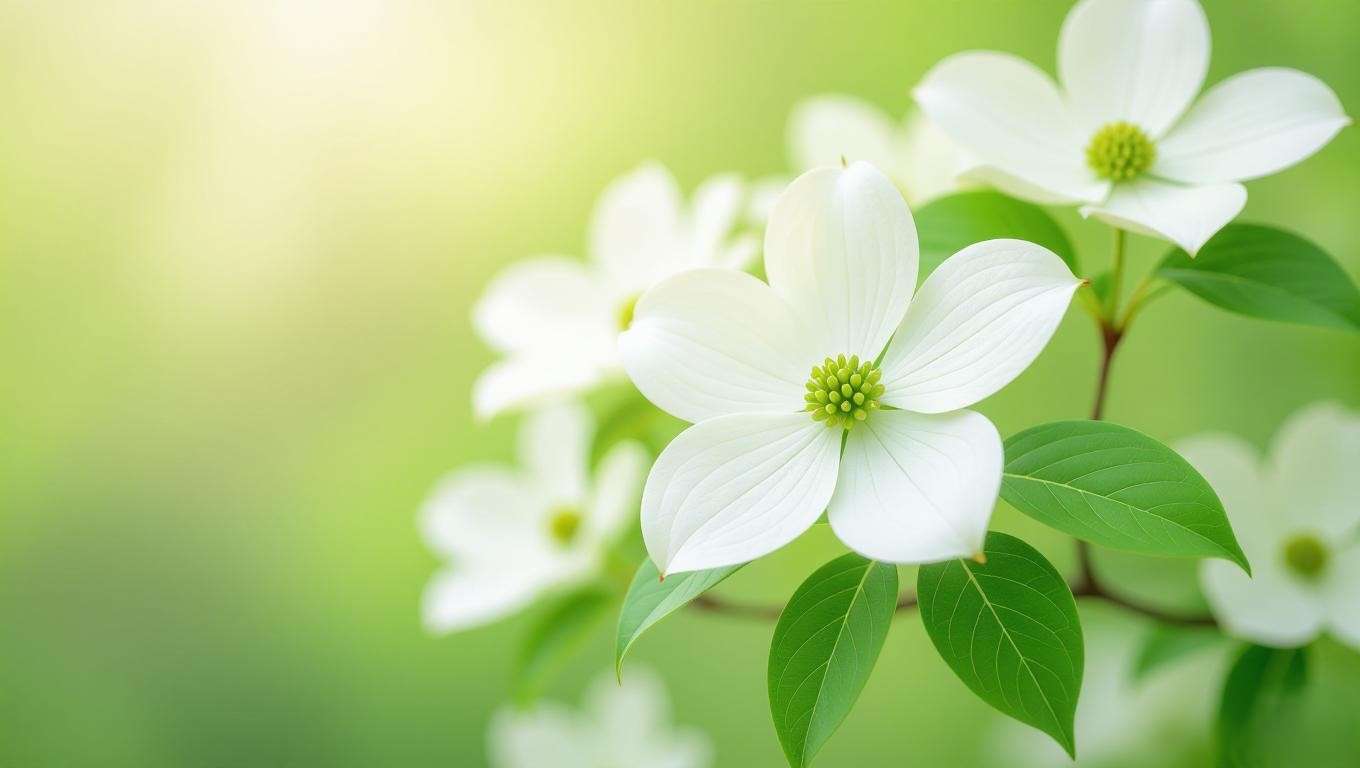
Tools and Resources for Identification
For quick identification, try apps like PlantSnap or iNaturalist, which analyze photos of flowers, leaves, and bark. Local university extension services or botanical gardens offer expert guidance, often free of charge. Tip: Take clear photos of your tree’s flowers, leaves, and bark, and note its location and bloom season to streamline the identification process.
Essential Care Tips for Trees with White Flowers 🌱
Once you’ve identified your tree, proper care ensures it thrives and produces vibrant blooms year after year. From planting to pruning, these expert tips will keep your tree healthy.
Planting and Site Selection
Choosing the right location is critical. Most white-flowered trees prefer well-drained, loamy soil with a slightly acidic to neutral pH (6.0–7.0). Test your soil with a home kit or consult a local nursery for advice. Sunlight needs vary—Dogwoods thrive in partial shade, while Crabapples prefer full sun (6+ hours daily). Ensure adequate spacing to prevent overcrowding, which can lead to disease. For example, plant Magnolias at least 15–20 feet apart to accommodate their wide canopies.
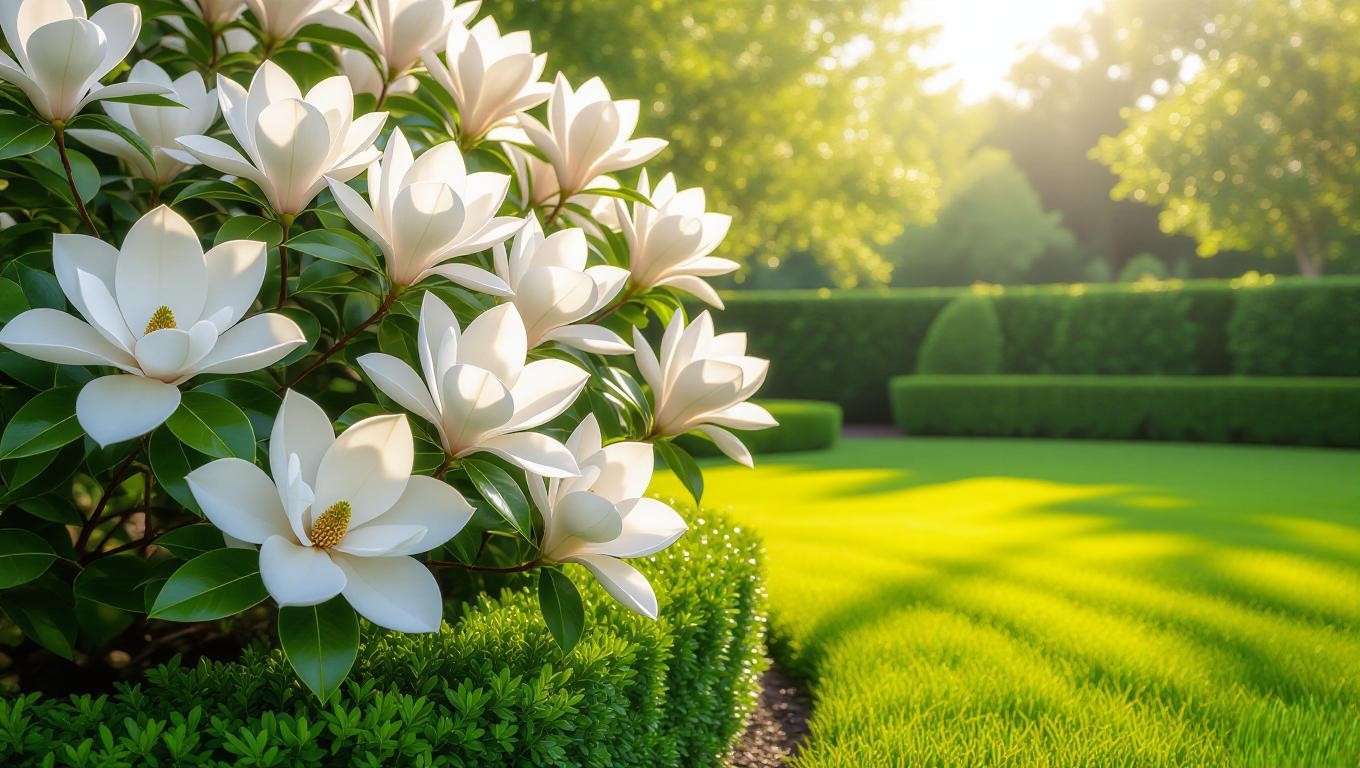
Watering and Fertilizing
Young trees need consistent watering—about 1 inch per week for the first two years. Established trees are more drought-tolerant but benefit from deep watering during dry spells. Use a balanced fertilizer (e.g., 10-10-10 NPK) in early spring to promote healthy growth and blooming. Avoid over-fertilizing, as excess nitrogen can reduce flower production. Tip: Apply fertilizer around the tree’s drip line, not near the trunk, for optimal nutrient absorption.
Pruning for Health and Beauty
Pruning enhances flower production and maintains tree shape. For most white-flowered trees, prune in late winter or early spring before new growth begins. Remove dead, damaged, or crossing branches using clean, sharp pruners ✂️. For Dogwoods, light pruning encourages air circulation, while Magnolias require minimal trimming to preserve their natural form. Certified arborist John Doe advises, “Always prune at a 45-degree angle above a bud to promote healthy regrowth.” Safety tip: Wear gloves and sterilize tools to prevent disease spread.
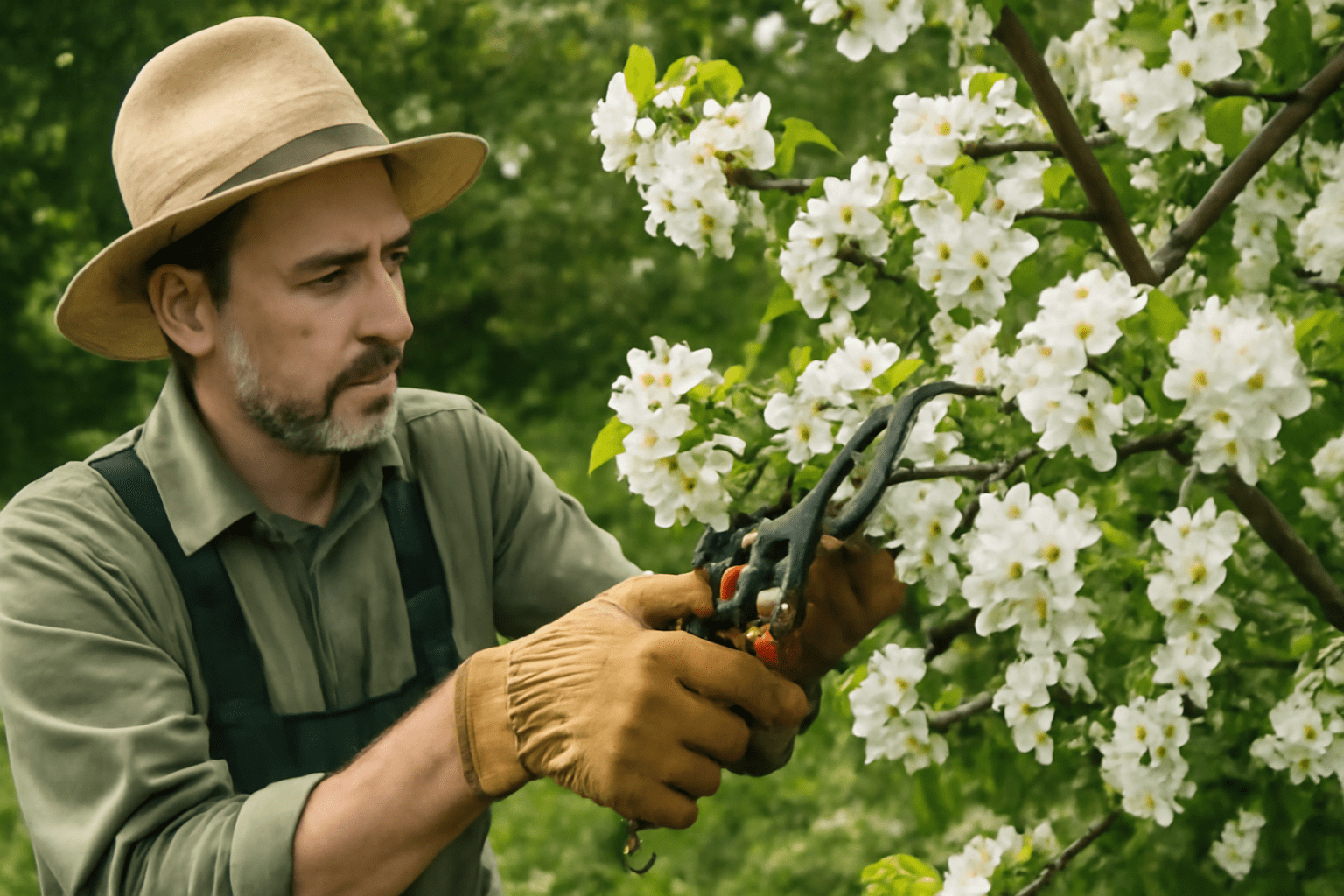
Troubleshooting Common Issues with White-Flowered Trees 🩺
Even with the best care, trees can face challenges. Knowing how to spot and address issues keeps your tree thriving.
Pests and Diseases
Common pests include aphids, which suck sap from leaves, and scale insects, which form hard shells on branches. Spray with neem oil or insecticidal soap for organic control. Diseases like powdery mildew (white coating on leaves) or anthracnose (dark leaf spots) can affect Dogwoods and Crabapples. Improve air circulation through pruning and avoid overhead watering to prevent fungal spread. Regular inspections catch problems early.
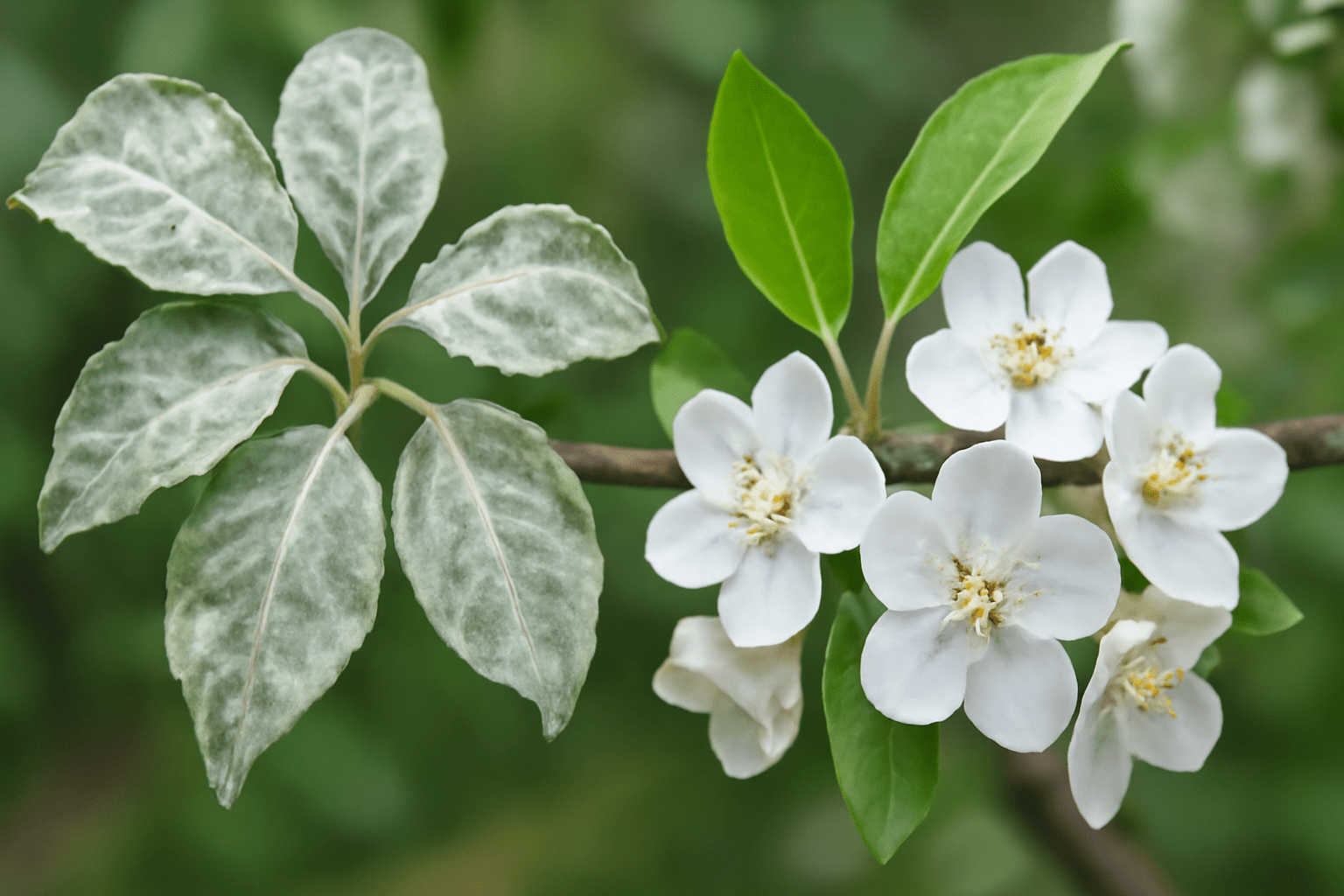
Environmental Stress
Poor blooming may result from drought, frost, or compacted soil. Mulch with 2–3 inches of organic material (e.g., wood chips) to retain moisture and regulate soil temperature. Deep water during dry periods, and aerate soil to improve root health. If frost is a concern, cover young trees with burlap during late cold snaps.
When to Call a Professional
Severe issues, like extensive dieback or structural damage, require a certified arborist. Find one through the International Society of Arboriculture (ISA) or your local extension service. Tip: Download our free “Tree Health Checklist” to diagnose common issues and know when to seek expert help.
Seasonal Care Calendar for Vibrant Blooms 📅
A consistent care routine ensures your tree’s blooms dazzle every season. Follow this schedule for optimal results.
Spring
- Fertilize: Apply a balanced fertilizer before blooming begins.
- Inspect: Check for pests and early signs of disease.
- Mulch: Add a fresh layer of mulch to conserve moisture.
Summer
- Water: Provide deep watering during dry spells, especially for young trees.
- Monitor: Watch for pests like aphids and treat promptly.
- Deadhead: Remove spent blooms (if applicable) to encourage new growth.
Fall
- Cleanup: Rake fallen leaves to prevent fungal diseases.
- Assess: Check tree health and plan for next season’s care.
- Reduce Watering: Gradually decrease watering as the tree enters dormancy.
Winter
- Protect: Wrap young trees in burlap to shield from frost or heavy snow.
- Plan: Research new care techniques or companion plants for spring.
- Prune: Perform light pruning for shape and health (if needed).
Visual Aid: Check out our infographic for a quick-reference seasonal care guide, available for download.

Enhancing Your Garden with White-Flowered Trees 🌷
A tree with white flowers can be the centerpiece of a stunning garden design. By pairing it with complementary plants and thoughtful landscaping, you can elevate both its beauty and functionality.
Companion Planting
Companion plants enhance the aesthetic and health of your white-flowered tree. Pair with colorful perennials like lavender or salvia to create vibrant contrast against white blooms. Low-growing shrubs, such as boxwood or azaleas, frame the tree’s base without competing for light. For ecological benefits, include pollinator-friendly plants like coneflowers or bee balm to attract bees 🐝 and butterflies 🦋, boosting your garden’s biodiversity. Avoid planting aggressive species, like ivy, that may compete for nutrients. Tip: Choose companions with similar soil and light needs to simplify care.
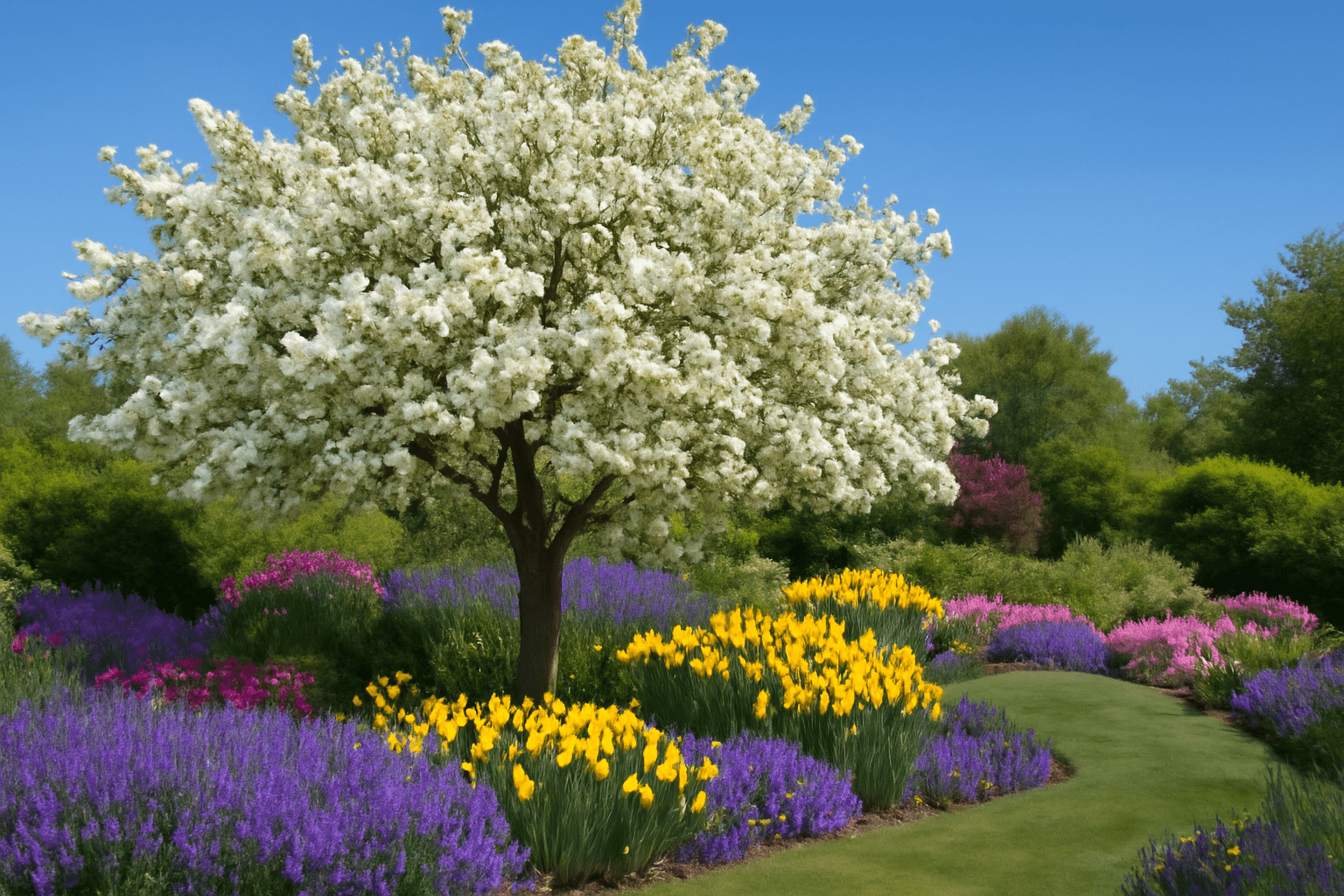
Design Ideas for Every Garden
White-flowered trees adapt to various garden sizes and styles:
- Small Gardens: Compact trees like Star Magnolia (Magnolia stellata) or dwarf Dogwood (Cornus kousa ‘Chinensis’) fit neatly into tight spaces, adding charm without overwhelming the area.
- Large Landscapes: A Southern Magnolia (Magnolia grandiflora) or large Crabapple (Malus ‘Snowdrift’) creates a dramatic focal point, ideal for open lawns or estate gardens.
- Urban Settings: Serviceberry (Amelanchier spp.) or Hawthorn (Crataegus spp.) thrive in pollution-prone areas, offering resilience and beauty for city dwellers.
Case Study: Homeowner Sarah from Virginia transformed her small backyard with a White Fringe Tree (Chionanthus virginicus). By planting it near a patio and surrounding it with low-maintenance perennials, she created a cozy, inviting space that blooms vibrantly each spring.
FAQs About Trees with White Flowers ❓
Below are answers to common questions about trees with white flowers, designed to address reader concerns and boost SEO through featured snippet optimization.
- How can I tell if my tree with white flowers is healthy?
A healthy tree has vibrant green leaves, consistent blooming, and no signs of wilting or discoloration. Check for firm, smooth bark and inspect roots for rot during replanting. Regular monitoring ensures early detection of issues. - Why isn’t my tree blooming as much as it used to?
Reduced blooming may stem from insufficient sunlight, nutrient deficiencies, or improper pruning. Ensure your tree gets adequate light (check species requirements), fertilize annually, and prune at the right time (e.g., late winter for Dogwoods). - Are white-flowered trees safe for pets or children?
Most, like Dogwoods and Magnolias, are non-toxic, but some, like certain Hawthorns, may have thorns or berries that pose risks. Always verify with resources like the ASPCA’s plant toxicity database before planting near pets or kids. - What’s the best time to plant a tree with white flowers?
Early spring or fall is ideal for most species, allowing roots to establish before extreme weather. Check your USDA zone for precise timing (e.g., zones 5–9 for Dogwoods). - Can these trees grow in my climate zone?
Many white-flowered trees, like Crabapples and Serviceberries, adapt to a wide range of climates (zones 4–8). Consult the USDA Plant Hardiness Zone Map or a local nursery to confirm suitability.
Conclusion: Grow Your Dream Tree with Confidence 🌲
Trees with white flowers bring unmatched beauty and ecological value to any garden. By accurately identifying your tree—whether it’s a Dogwood, Magnolia, or Serviceberry—and following our expert care tips, you can ensure vibrant, healthy blooms year after year. From proper planting and seasonal care to troubleshooting pests and designing a stunning landscape, this guide equips you with everything you need to succeed. Start by snapping a photo of your tree to identify it, apply our watering and pruning techniques, or explore companion planting to elevate your garden’s charm. For more resources, download our free “White-Flowered Tree Care Guide” or join our plant care community to connect with fellow enthusiasts. Let your tree shine as the star of your outdoor space! 🌳

